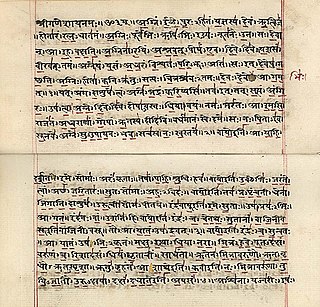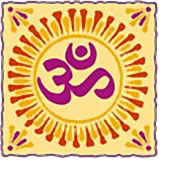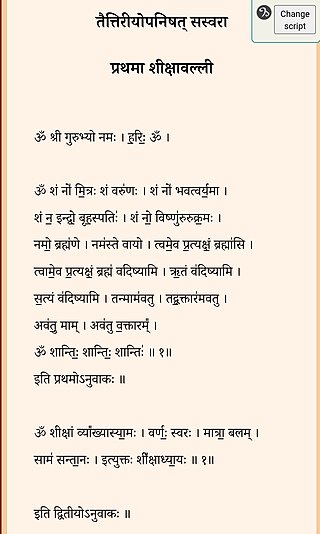
The Upanishads are late Vedic and post-Vedic Sanskrit texts that "document the transition from the archaic ritualism of the Veda into new religious ideas and institutions" and the emergence of the central religious concepts of Hinduism. They are the most recent addition to the Vedas, the oldest scriptures of Hinduism, and deal with meditation, philosophy, consciousness, and ontological knowledge. Earlier parts of the Vedas dealt with mantras, benedictions, rituals, ceremonies, and sacrifices.

In Indian religions, a rishi is an accomplished and enlightened person. They find mentions in various Vedic texts. Rishis are believed to have composed hymns of the Vedas. The Post-Vedic tradition of Hinduism regards the rishis as "great yogis" or "sages" who after intense meditation (tapas) realized the supreme truth and eternal knowledge, which they composed into hymns. The term appears in Pali literature as Ishi; in Buddhism they can be either Buddhas, Paccekabuddhas, Arahats or a monk of high rank.

Swami Dayananda Saraswati was a renunciate monk of the Hindu Saraswati order of sannyasa. He was also known as Pujya Swamiji and was a traditional teacher of Advaita Vedanta. He was the founder of the Arsha Vidya Gurukulams in Pennsylvania, USA; Rishikesh, Uttarakhand and Coimbatore Tamil Nadu, India. He was also the spiritual Guru of Prime Minister Narendra Modi. He was awarded the Padma Bhushan,, for his service to the nation in the field of spiritualism in 2016.

The Yajurveda is the Veda primarily of prose mantras for worship rituals. An ancient Vedic Sanskrit text, it is a compilation of ritual-offering formulas that were said by a priest while an individual performed ritual actions such as those before the yajna fire. Yajurveda is one of the four Vedas, and one of the scriptures of Hinduism. The exact century of Yajurveda's composition is unknown, and estimated by Witzel to be between 1200 and 800 BCE, contemporaneous with Samaveda and Atharvaveda.
Saccidānanda is an epithet and description for the subjective experience of the ultimate unchanging reality, called Brahman, in certain branches of Hindu philosophy, especially Vedanta. It represents "existence, consciousness, and bliss" or "truth, consciousness, bliss".

The Isha Upanishad, also known as Shri Ishopanishad, Ishavasya Upanishad, or Vajasaneyi Samhita Upanishad, is one of the shortest Upanishads, embedded as the final chapter (adhyāya) of the Shukla Yajurveda. It is a Mukhya Upanishad, and is known in two recensions, called Kanva (VSK) and Madhyandina (VSM). The Upanishad is a brief poem, consisting of 17 or 18 verses, depending on the recension.
Principal Upanishads, also known as Mukhya Upanishads, are the most ancient and widely studied Upanishads of Hinduism. Composed between 800 BCE to the start of common era, these texts are connected to the Vedic tradition.
Prasthanatrayi, literally, three sources , refers to the three canonical texts of theology having epistemic authority, especially of the Vedanta schools. It consists of:
- The Upanishads, known as Upadeśa Prasthāna, and the Śruti Prasthāna, especially the Principal Upanishads.
- The Bhagavad Gita, known as Sādhana Prasthāna, and the Smṛti Prasthāna
- The Brahma Sutras, known as Sūtra Prasthāna or Nyāya Prasthāna or Yukti Prasthāna
The Taittirīya Shakha, is a shakha of the Krishna (black) Yajurveda. Most prevalent in South India, it consists of the Taittirīya Samhita ('TS'), Taittirīya Brahmana ('TB'), Taittirīya Aranyaka ('TA'), and Taittirīya Pratisakhya ('TP').

Svādhyāya is a Sanskrit term which means self-study and especially the recitation of the Vedas and other sacred texts. It is also a broader concept with several meanings. In various schools of Hinduism, Svadhyaya is a Niyama connoting introspection and "study of self".

Pranava yoga is meditation on the sacred mantra Om, as outlined in the Upanishads, the Bhagavad Gita, and the Yoga Sutras of Patanjali. It is also called Aum yoga and Aum yoga meditation. It is, simply put, fixing the mind on the sound of the mantra "Aum" – the sacred syllable that both symbolizes and embodies Brahman, the Absolute Reality – as the mantra is constantly repeated in unison with the breath. The purpose of pranava yoga is to become free from suffering and limitation.
The Shanti Mantras, or Pancha Shanti mantras, are Hindu prayers for peace (shanti) found in the Upanishads. Generally, they are recited at the beginning and end of religious rituals and discourses.

Advaita Ashrama, Mayavati, is a branch of the Ramakrishna Math, founded on 19 March 1899 at the behest of Vivekananda, by his disciples James Henry Sevier, and Charlotte Sevier. Today it publishes the original writings of Vivekananda. As an ashram dedicated to the study and practice of Advaita Vedanta, no images or idols are worshipped there, not even of Ramakrishna; and no images were kept in the premises according to the Ashram ideals set by Vivekananda.
Para Brahman or Param Brahman in Hindu philosophy is the "Supreme Brahman" that which is beyond all descriptions and conceptualisations. It is described as the formlessness that eternally pervades everything, everywhere in the universe and whatever is beyond.
Sri Anirvan, born Narendra Chandra Dhar, was an Indian Hindu monk, writer and philosopher. Widely known as a scholar, his principal works were a Bengali translation of Sri Aurobindo's The Life Divine and the three-volume treatise Veda Mimamsa.

The Taittiriya Upanishad is a Vedic era Sanskrit text, embedded as three chapters (adhyāya) of the Yajurveda. It is a mukhya Upanishad, and likely composed about 6th century BCE.

The Rigveda or Rig Veda is an ancient Indian collection of Vedic Sanskrit hymns (sūktas). It is one of the four sacred canonical Hindu texts (śruti) known as the Vedas. Only one Shakha of the many survive today, namely the Śakalya Shakha. Much of the contents contained in the remaining Shakhas are now lost or are not available in the public forum.
Chaitanya refers variously to 'awareness', 'consciousness', 'Conscious Self', 'intelligence' or 'Pure Consciousness'. It can also mean energy or enthusiasm. The meaning of name Chaitanya also stands for "State of Conscious Energy".
In Advaita Vedanta and Jnana Yoga Nididhyasana is profound and repeated meditation on the mahavakyas, great Upanishadic statements such as "That art Thou", to realize the identity of Atman and Brahman. It is the fourth step in the training of a sisya (disciple), consisting of preparatory practices, listening to the teachings as contained in the sruti, reflection on the teachings, and nididhyasana.

The Swaminarayan Bhashyam (Svāminārāyaṇabhāṣyam) is a five-volume Sanskrit bhashya, or commentary, on the Prasthanatrayi (Prasthānatrayī) - the ten principal Upanishads (Upaniṣads), the Bhagavad Gita (Bhagavadgītā), and the Brahmasutras (Brahmasūtras) - which establishes the principles taught by Swaminarayan as perceived by the BAPS.











